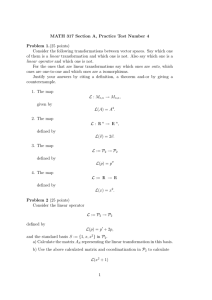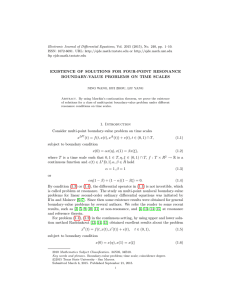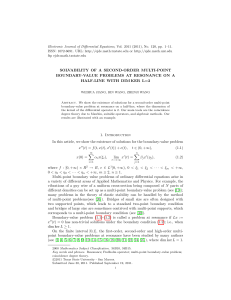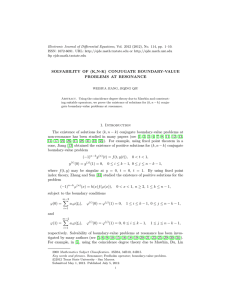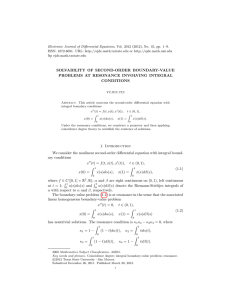Electronic Journal of Differential Equations, Vol. 2003(2003), No. 112, pp.... ISSN: 1072-6691. URL: or
advertisement
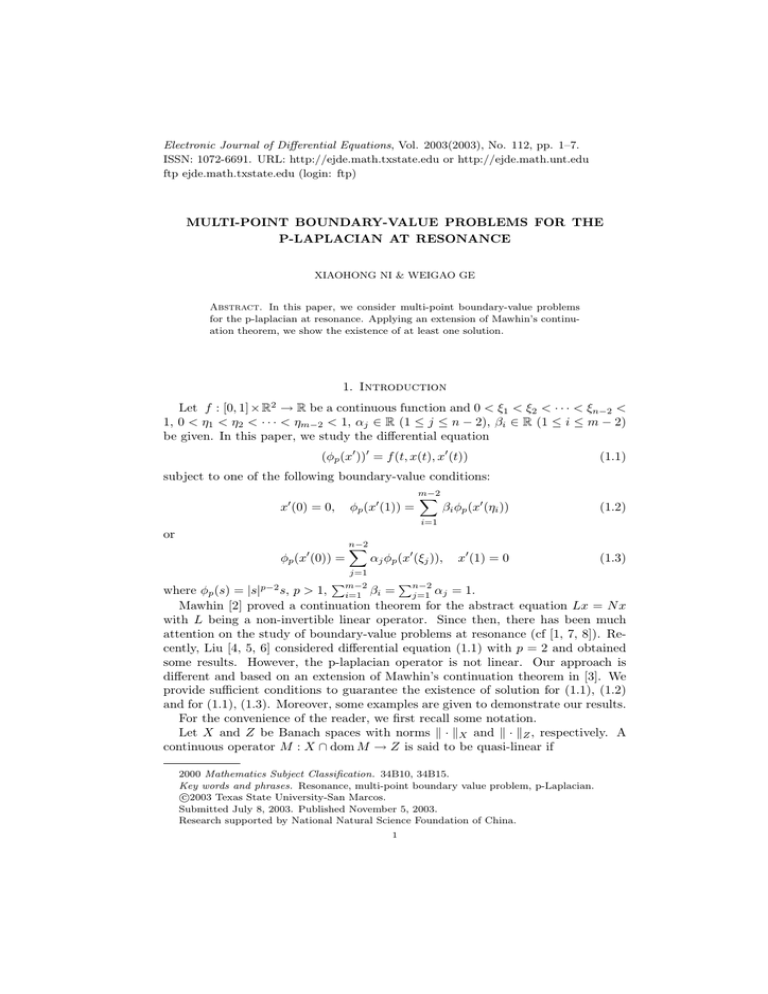
Electronic Journal of Differential Equations, Vol. 2003(2003), No. 112, pp. 1–7.
ISSN: 1072-6691. URL: http://ejde.math.txstate.edu or http://ejde.math.unt.edu
ftp ejde.math.txstate.edu (login: ftp)
MULTI-POINT BOUNDARY-VALUE PROBLEMS FOR THE
P-LAPLACIAN AT RESONANCE
XIAOHONG NI & WEIGAO GE
Abstract. In this paper, we consider multi-point boundary-value problems
for the p-laplacian at resonance. Applying an extension of Mawhin’s continuation theorem, we show the existence of at least one solution.
1. Introduction
Let f : [0, 1] × R2 → R be a continuous function and 0 < ξ1 < ξ2 < · · · < ξn−2 <
1, 0 < η1 < η2 < · · · < ηm−2 < 1, αj ∈ R (1 ≤ j ≤ n − 2), βi ∈ R (1 ≤ i ≤ m − 2)
be given. In this paper, we study the differential equation
(φp (x0 ))0 = f (t, x(t), x0 (t))
(1.1)
subject to one of the following boundary-value conditions:
x0 (0) = 0,
φp (x0 (1)) =
m−2
X
βi φp (x0 (ηi ))
(1.2)
i=1
or
φp (x0 (0)) =
n−2
X
αj φp (x0 (ξj )),
x0 (1) = 0
(1.3)
j=1
Pm−2
Pn−2
where φp (s) = |s|p−2 s, p > 1, i=1 βi = j=1 αj = 1.
Mawhin [2] proved a continuation theorem for the abstract equation Lx = N x
with L being a non-invertible linear operator. Since then, there has been much
attention on the study of boundary-value problems at resonance (cf [1, 7, 8]). Recently, Liu [4, 5, 6] considered differential equation (1.1) with p = 2 and obtained
some results. However, the p-laplacian operator is not linear. Our approach is
different and based on an extension of Mawhin’s continuation theorem in [3]. We
provide sufficient conditions to guarantee the existence of solution for (1.1), (1.2)
and for (1.1), (1.3). Moreover, some examples are given to demonstrate our results.
For the convenience of the reader, we first recall some notation.
Let X and Z be Banach spaces with norms k · kX and k · kZ , respectively. A
continuous operator M : X ∩ dom M → Z is said to be quasi-linear if
2000 Mathematics Subject Classification. 34B10, 34B15.
Key words and phrases. Resonance, multi-point boundary value problem, p-Laplacian.
c
2003
Texas State University-San Marcos.
Submitted July 8, 2003. Published November 5, 2003.
Research supported by National Natural Science Foundation of China.
1
2
XIAOHONG NI & WEIGAO GE
EJDE–2003/112
(i) Im M = M (X ∩ dom M ) is a closed subset of Z;
(ii) Ker M = {x ∈ X ∩ dom M : M x = 0} is linearly homeomorphic to Rn ,
n < ∞.
Let P : X → X1 and Q : Z → Z1 be two projectors such that Im P = Ker M ,
Ker Q = Im M and X = X1 ⊕ X2 , Z = Z1 ⊕ Z2 , where X1 = Ker M , Z2 = Im M
and X2 , Z1 are respectively the complement space of X1 in X, Z2 in Z. If Ω is an
open and bounded subset of X such that dom M ∩ Ω 6= Φ, the continuous operator
Nλ : Ω → Z, λ ∈ [0, 1] will be called admissibly compact in Ω with respect to M if
(iii) There is a subset Z1 of Z with dim Z1 = dim X1 and an operator K :
Im M → X2 with Kθ = θ such that for λ ∈ [0, 1],
(I − Q)Nλ (Ω̄) ⊂ Im M ⊂ (I − Q)Z,
(I − Q)N0 is a zero operator, and QNλ x = 0 ⇔ QN x = 0, λ ∈ (0, 1),
(1.4)
(1.5)
KM = I − P, K(I − Q)Nλ : Ω → X2 ⊂ X is compact,
(1.6)
M [P + K(I − Q)Nλ ] = (I − Q)Nλ .
(1.7)
Theorem 1.1 ([3]). Let X and Z be two Banach spaces with the norms k · kX and
k·kZ , respectively, and Ω ⊂ X an open and bounded set. Suppose M : X ∩dom M →
Z is a quasi-linear operator and Nλ : Ω → Z is admissibly compact with respect to
M . In addition, if
(C1) M x 6= Nλ x, λ ∈ (0, 1), x ∈ ∂Ω
(C2) deg{JQN, Ω ∩ Ker M, 0} =
6 0, where N = N1 and J : Z1 → X1 is a
homeomorphism with J(0) = 0;
then the abstract equation M x = N x has at least one solution in Ω.
2. General Results
2.1. Results for boundary-value problem (1.1), (1.2). Let X = {x ∈ C[0, 1] :
Pm−2
x0 (0) = 0, φp (x0 (1)) = i=1 βi φp (x0 (ηi ))} with norm kxk1 = max{kxk, kx0 k} and
Z = C[0, 1] with norm kwk = maxt∈[0,1] |w(t)|. Let M be the operator from
dom M ⊂ X to Z with
dom M = {x ∈ C 1 [0, 1] : φp (x0 ) ∈ C 1 [0, 1]}
and M x = (φp (x0 ))0 . For any open and bounded Ω ⊂ X, we define Nλ : Ω → Z by
(Nλ x) = λf (t, x(t), x0 (t)),
t ∈ [0, 1]
Then (1.1), (1.2) can be written as
M x = N x,
where N = N1 .
Lemma 2.1. If 0 < η1 < η2 < · · · < ηm−2 < 1, then there exists integer k ∈
Pm−2
{1, 2, . . . , m − 1} such that i=1 βi ηik 6= 1.
Proof. If this were not the case,
η1
η2
2
η12
η
2
..
..
.
.
η1m−1 η2m−1
we have
...
...
..
.
...
ηm−2
β1
1
2
β2 1
ηm−2
.. .. = .. .
.
. .
m−1
βm−2
1
ηm−2
EJDE–2003/112
MULTI-POINT BOUNDARY-VALUE PROBLEMS
3
This implies
η1
η12
..
.
η1m−1
η2
η22
..
.
...
...
..
.
ηm−2
2
ηm−2
..
.
η2m−1
...
m−1
ηm−2
β1
0
1
β
2 0
1
.. ..
.. . = . .
.
βm−2 0
1
−1
0
Putting
η1
η12
..
.
A=
η1m−1
η2
η22
..
.
...
...
..
.
ηm−2
2
ηm−2
..
.
η2m−1
...
m−1
ηm−2
1
1
..
.
1
we have
1
η1
det A = η1 η2 ηm−2 .
..
m−2
η
1
1
η2
..
.
...
...
..
.
1
ηm−2
..
.
η2m−2
...
m−2
ηm−2
1
1
.. 6= 0.
. 1
Hence, (β1 , β2 , . . . , βm−2 , −1)T = (0, 0, . . . , 0, 0)T , which leads to a contradiction,
−1 = 0.
Pm−2
Lemma 2.2. If i=1 βi = 1, then the operator M : dom M ∩ X → Z is a quasilinear and Nλ : Ω → Z is admissibly compact in Ω with respect to M .
Proof. Obviously, X1 = Ker M = { x = A, A ∈ R} and
m−2
XZ 1
Z2 = Im M = y ∈ Z,
βi y(s)ds = 0 .
i=1
ηi
We have dim Ker M = 1 < ∞ and M (X ∩ dom M ) ⊂ Z closed. Hence, M is a
quasi-linear operator. Define projectors P : X → X1 as P x = x(0) for all x ∈ X
and Q : Z → Z1 as
m−2
i
h
X Z 1
k
β
y(s)ds
tk−1 , ∀y ∈ Z.
Qy =
Pm−2
i
1 − i=1 βi ηik i=1
ηi
where Z1 is the complement space of Z2 in Z. (Indeed, Z1 ∼
= R). Thus dim X1 =
dim Z1 = 1.
Taking K : Im M → X2 as follows:
Z t
Z s
((I − Q)h(τ )dτ ds, ∀h(t) ∈ Z.
K(I − Q)h(t) =
φ−1
p
0
0
here X2 is the complement space of X1 in X. It is clear that Kθ = θ and (1.4),
(1.5) hold. For for all x ∈ X ∩ dom M , we have
M [P + K(I − Q)Nλ ]x = (I − Q)Nλ x
and
Z
KM x = K(I − Q)M x =
0
t
Z
φ−1
p (
0
s
(φp (x0 (τ )))0 dτ )ds = x(t) − x(0) = (I − P )x.
4
XIAOHONG NI & WEIGAO GE
EJDE–2003/112
For any open and bounded set Ω ⊂ X, λ ∈ [0, 1], by using the Ascoli-Arzela Theorem, we can prove that [K(I − Q)Nλ ](Ω) is relatively compact and continuous.
This implies that (1.6), (1.7) are valid. Hence, Nλ is admissibly compact in Ω with
respect to M .
For the next theorem we have the assumptions:
(H1) There exist functions a, b, r ∈ C([0, 1], [0, +∞)) such that for all (x, y) ∈ R2 ,
t ∈ [0, 1],
|f (t, x, y)| ≤ φp [a(t)|x| + b(t)|y| + r(t)].
(H2) There exists a constant C > 0 such that for any x ∈ X, if |x(t)| > c, for all
t ∈ [0, 1], one has
m−2
X Z 1
sgn(x(t))
βi
f (t, x(t), x0 (t))dt < 0
(2.1)
ηi
i=2
or
sgn(x(t))
m−2
X
Z
1
βi
i=2
f (t, x(t), x0 (t))dt > 0
(2.2)
ηi
Theorem 2.3. Suppose f : [0, 1] × R2 → R is a continuous function and 0 < η1 <
η2 < · · · < ηm−2 < 1, βi ∈ R (1 ≤ i ≤ m − 2) are given. Under Assumptions (H1)
Pm−2
and (H2), the boundary-value problem (1.1), (1.2) with i=1 βi = 1 has at least
one solution provided that kak + kbk < 1.
Proof. Set Ω1 = {x ∈ X ∩ dom M, M x = Nλ x, λ ∈ (0, 1)}, then for x ∈ Ω1 ,
M x = Nλ x. Thus, we have N x ∈ Im M = Ker Q and
m−2
X Z 1
βi
f (t, x(t), x0 (t))dt = 0.
i=2
ηi
By (H2), there exists t0 ∈ [0, 1] such that |x(t0 )| ≤ C. Hence, we have kxk ≤
Rt
C + kx0 k, in view of the relation x(t) = x(t0 ) + t0 x0 (s)ds. At the same time,
0
|x0 (t)| ≤ φ−1
p (kN xk) ≤ kakkxk + kbkkx k + krk.
Noticing kak + kbk < 1, we know the set Ω1 is bounded. Let kxk1 ≤ C ∗ for all
x ∈ Ω1 .
If (2.1) holds, taking H(x, λ) = −λIx + (1 − λ)JQN x, λ ∈ [0, 1] and
Ω2 = {x ∈ Ker M, H(x, λ) = 0},
where J : Im Q → Ker M is a homomorphism such that J(Atk−1 ) = A, for all
A ∈ R. We claim that for any x ∈ Ω2 , kxk1 ≤ C. In fact, if this were not the
case, there exist λ0 ∈ [0, 1] and |x0 | > C such that H(x0 , λ0 ) = 0. Without loss of
Pm−2
generality, suppose x0 > C and i=1 βi ηik < 1. If λ0 = 1, then x0 = 0 otherwise,
it implies that
m−2
X Z 1
k
βi
f (t, x0 , 0)dt < 0,
0 ≤ λ0 x0 = (1 − λ0 )
Pm−2
1 − i=1 βi ηik i=2
ηi
which leads to a contradiction, 0 < 0.
When (2.2) holds, putting H(x, λ) = λIx+(1−λ)JQN x. By a similar argument,
we can obtain the same conclusion.
EJDE–2003/112
MULTI-POINT BOUNDARY-VALUE PROBLEMS
5
Next, we shall prove that all conditions of Theorem 1.1 are satisfied. Let Ω be
2
S
Ωi ⊂ Ω. Clearly, we have
an open bounded subset of X such that
i=1
M x 6= Nλ x,
λ ∈ (0, 1), x ∈ ∂Ω
and
H(x, λ) 6= 0,
λ ∈ [0, 1], x ∈ ∂Ω ∩ Ker M.
In view of the homotopy property of degree,
deg{JQN, Ω ∩ Ker M, 0} = deg{−I, Ω ∩ Ker M, 0} = −1.
Theorem 1.1 canP
be generalized to obtain the existence of at least one solution for
m−2
(1.1), (1.2) with i=2 βi = 1.
2.2. Results for Problem (1.1), (1.3). Let X = {x ∈ C[0, 1] : φp (x0 (0)) =
Pn−2
0
0
j=1 αj φp (x (ξj )), x (1) = 0}. Z, M, dom M and Nλ be defined as above.
Pn−2
Pn−2
Lemma 2.4. If j=1 αj = 1 and j=1 αj ξj 6= 0 then operator M : dom M ∩X →
Z is a quasi-linear and Nλ : Ω → Z is admissibly compact in Ω with respect to M .
Pn−2 R ξj
Note that Ker M = {x = A, A ∈ R} and Im M = {y ∈ Z,
j=1 αj 0 y(s)ds =
0}. We define P : X → X1 , and Q : Z → Z1 as follows:
(P x)(t) = x(0),
n−2
X
1
(Qy)(t) = Pn−2
j=1
αj ξj
j=1
Z
ξj
αj
y(s)ds.
0
R1
Rt
Let K(I −Q)h(t) = − 0 φ−1
((I −Q)h(τ )dτ ds, for h(t) ∈ Z. Using the method
p
s
in the proof of Lemma 2.2, we can show the theorem bellow. However, we need the
assumption:
(H3) There exists a constant D > 0 such that for all x ∈ X, if |x(t)| > D for
some t ∈ [0, 1], one has
sgn(x(t))
n−2
X
Z
ξj
αj
f (t, x(t), x0 (t))dt < 0
(2.3)
f (t, x(t), x0 (t))dt > 0
(2.4)
0
j=1
or
sgn(x(t))
n−2
X
j=1
Z
αj
ξj
0
Theorem 2.5. Suppose that f : [0, 1] × R2 → R is continuous, 0 < ξ1 < ξ2 < · · · <
ξn−2 < 1, and αj ∈ R (1 ≤ j ≤ n − 2) are given. Under Assumptions (H1), (H3),
Pn−2
Pn−2
the boundary-value problem (1.1), (1.3) with j=1 αj = 1, j=1 αj ξj 6= 0 has at
least one solution provided that kak + kbk < 1.
The proof of this theorem is similar to that of Theorem 2.3; therefore, we omit
it here.
6
XIAOHONG NI & WEIGAO GE
EJDE–2003/112
3. Examples
Example 3.1. Consider the boundary-value problem, at resonance,
(cos(x0 ))2
1
x+
− 3t2 ,
3
2(t + 1)
(φp (x0 ))0 =
0
x (0) = 0,
0
φp (x (1)) =
m−2
X
t ∈ [0, 1]
(3.1)
0
βi φp (x (ηi ))
i=1
Pm−2
Pm−2
where p > 2, 0 < η1 < η2 < · · · < ηm−2 < 1, i=1 βi = 1, i=1 βi ηi 6= 1 and
βi (1 ≤ i ≤ m − 2) ≥ 0.
0 2
))
1
1
2
2
Let f (t, x, y) = 13 x + (cos(x
2(t+1) − 3t , then |f (t, x, y)| ≤ 3 |x| + 2 |y| + 3t ≤
1
1
φp ( 3 |x| + 2 |y| + 3). Clearly, there exists a constant C > 0 such that if |x(t)| > C,
for any t ∈ [0, 1], one has
m−2
X Z 1
sgn(x(t))
βi
f (t, x(t), x0 (t))dt > 0.
i=2
ηi
Applying Theorem 2.3, we obtain that (3.1) has at least one solution.
Example 3.2. Consider the boundary-value problem
1
1
(φp (x0 ))0 = x + x sin(x0 ) + t
4
12
(3.2)
1
1
φp (x0 (0)) = 3φp (x0 ( )) − 2φp (x0 ( )), x0 (1) = 0,
4
2
where p > 2, ξ1 = 41 , ξ2 = 12 , α1 = 3, α2 = −2. Taking f (t, x, y) = 14 x +
1
1
1
1
0
12 x sin(x ) + t, then |f (t, x, y)| ≤ 12 |x| + 4 |x| + 1 ≤ φp ( 3 |x| + 1) and for any A ∈ R,
Z 41
Z 12
5
A3
− .
3
f (t, A, 0)dt − 2
f (t, A, 0)dt = −
4
32
0
0
Hence, there exists a constant D > 0 such that for t ∈ [0, 1]
n−2
n−2
X Z ξj
X Z ξj
f (t, D, 0)dt < 0 <
αj
f (t, −D, 0)dt.
αj
j=1
0
j=1
0
From Theorem 2.5, Problem (3.2) has at least one solution.
References
[1] J. Bouchala, Resonance problems for p-laplacian, Math. Compu. Simulation, 61(2003), 599604.
[2] R. Gaines, J. Mawhin; Coincide degree and nonlinear differential equation, Springer-Verlag,
Berlin, 1977.
[3] W. G. Ge, J. L. Ren; An extension of Mawhin’s continuation theorem and its application to
boundary value problems with a p-laplacian, (preprint).
[4] B. Liu, J. S. Yu; Solvability of multi-point boundary value problems at resonance (I), India.
J. Pure. Math, 33(2002), 475-494.
[5] B. Liu, Solvability of multi-point boundary value problem at resonance (II), Appl. Math.
Compu, 136(2003), 353-377.
[6] B. Liu, J. S. Yu; Solvability of multi-point boundary value problem at resonance (III), Appl.
Math. Compu, 129(2002), 119-143.
[7] R. Y. Ma, Multilicity results for a third order boundary value problem at resonance, Nonlinear
Anal. Theo. Meth. Appl, 32(1998), 493-499.
EJDE–2003/112
MULTI-POINT BOUNDARY-VALUE PROBLEMS
7
[8] B. Przeradzki, Nonlinear equations at resonance with two solutions, Nonlinear Anal,
38(1999), 1023-1031.
Department of Applied Mathematics, Beijing Institute of Technology, Beijing 100081,
China
E-mail address, Xiaohong Ni: nixiaohong1126@hotmail.com




